
Special Hobby 1/48 Wirraway
| KIT #: | SH 48054 |
| PRICE: | 6500 yen at Hobby Link Japan |
| DECALS: | Three options |
| REVIEWER: | Tom Cleaver |
| NOTES: |

| HISTORY |
Three Royal Australian Air Force officers, led by Wing Commander
Lawrence Wackett, were sent on an overseas evaluation mission in 1936 to
select an aircraft type for local production in Australia. The aircraft
selected was the North American Aviation (NAA) NA‑16.
This caused a huge political storm in Australia, since it had been
assumed that when the new government-sponsored Commonwealth Aircraft
Corporation was created, that British aircraft would be chosen for
production. Charles Grey,
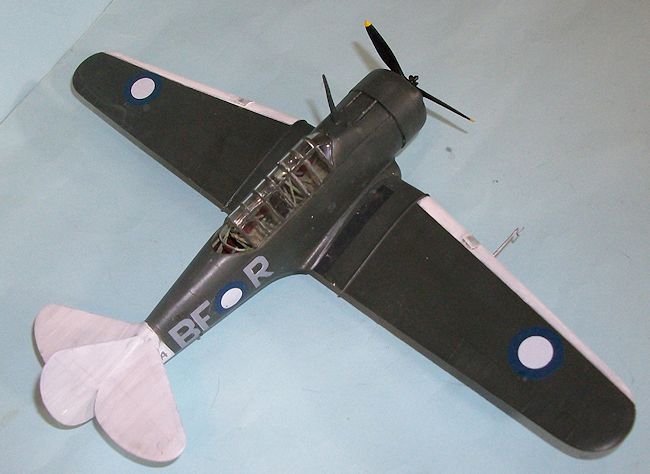 ditor of
The Aeroplane, waged a detailed misinformation campaign against the
type in an attempt to reverse the decision, but W/C Wackett was able to
demonstrate that the NA-16 was the most modern type available that could be
manufactured by a previously-nonexistant aircraft manufacturing indusry, and
the decision was confirmed.
ditor of
The Aeroplane, waged a detailed misinformation campaign against the
type in an attempt to reverse the decision, but W/C Wackett was able to
demonstrate that the NA-16 was the most modern type available that could be
manufactured by a previously-nonexistant aircraft manufacturing indusry, and
the decision was confirmed.
A production licence was obtained in 1937.
Two NA‑16s were purchased from North American Aviation to act as
prototypes. The first being the fixed undercarriage NA‑16‑1A, which was
similar in design to the BT‑9; the second was the retractable undercarriage
NA‑16‑2K, which was similar to the BC‑1. They were also known by their NAA
project accounting codes, NA‑32 for the NA‑16‑1A and NA‑33 for the NA‑16‑2K,
which subsequently has led historians to confusion. The NA‑16‑1A arrived in
Australia in August 1937 and flew for the first time at Laverton on
September 3, 1937. The NA‑16‑2K arrived in late September 1937 and flew
shortly afterwards. They were given RAAF serials A20‑1 and A20‑2.
The NA‑16‑2K was selected for production, with several detail and
structural changes, such as provision for two forward‑firing .30-caliber
machine guns instead of the NA‑16's one, and a strengthened structure to
allow dive‑bombing operations, since the Wirraway was also seen as a close
support aircraft for the Army, as well as a trainer.
The first CA‑1 Wirraway, serial A20‑3, made its first flight on March
27, 1939. The first two
Wirraways delivered to the RAAF were A20‑4 and A20‑5, on July 10, 1939. By
the outbreak of World War II the RAAF had received six Wirraways. Forty CA‑1
Wirraways were built before the CA‑3 entered production, the change in
designation having more to do with the
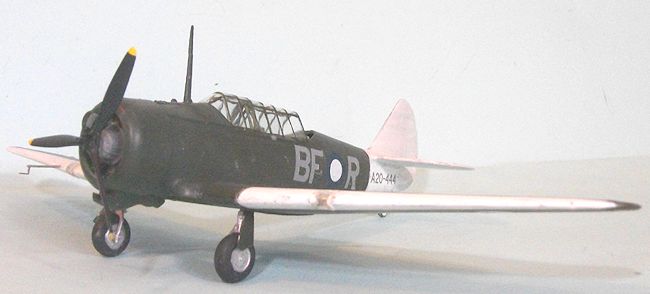 new one
being built to a different government contract than any difference between
the sub‑types. The CA‑5, CA‑7, CA‑8 and CA‑9 were all similar to the CA‑3;
the CA‑16 had substantial design changes, which included wing modifications
to allow a heavier bomb load and dive brakes for dive‑bombing.
“Dive bomber” wings were built under the designation of CA‑10A and
retrofitted to CA‑3s, ‑5s, ‑7s and ‑9s, with 113 Wirraways converted. CA‑16
A20‑757, the last of 755 Wirraways built, was delivered to the RAAF in July
1946.
new one
being built to a different government contract than any difference between
the sub‑types. The CA‑5, CA‑7, CA‑8 and CA‑9 were all similar to the CA‑3;
the CA‑16 had substantial design changes, which included wing modifications
to allow a heavier bomb load and dive brakes for dive‑bombing.
“Dive bomber” wings were built under the designation of CA‑10A and
retrofitted to CA‑3s, ‑5s, ‑7s and ‑9s, with 113 Wirraways converted. CA‑16
A20‑757, the last of 755 Wirraways built, was delivered to the RAAF in July
1946.
Beside serving as a trainer aircraft Wirraways were also operated in
combat roles. At the outbreak
of the Pacific War in December 1941 Wirraways equipped seven RAAF squadrons:
Noumbers 4, 5, 12, 22, 23, 24 and 25.
The first to see combat were a group of five Wirraways based at
Kluang in Malaya for training purposes which were pressed into combat
against the Japanese, being flown by New Zealanders with Australian
observers. They were quickly
dispatched by the Japanese.
On January 6, 1942, Wirraways of No. 24 Squadron based at Rabaul
attempted to intercept Japanese seaplanes flying over New Britain.
One managed to engage, marking the first air‑to‑air combat between
the RAAF and the Japanese. Two weeks later, eight Wirraways defended the
city of Rabaul from an attack by over 100 Japanese
bombers and fighters, with all but two of the Wirraways lost.
On December 12, 1942, Pilot Officer J. S. Archer shot down a Zero
after spotting it 1000 feet below and diving on it, opening fire and sending
the Zero hurtling into the sea. This was the only Wirraway aerial victory,
and is one more than the number
shot down by its offspring, the Boomerang. Wirraways operated over New
Guinea and later Bougainville on ground attack and other Army co‑operation
missions in concert with the Boomerang, establishing an excellent record
with the ground forces.
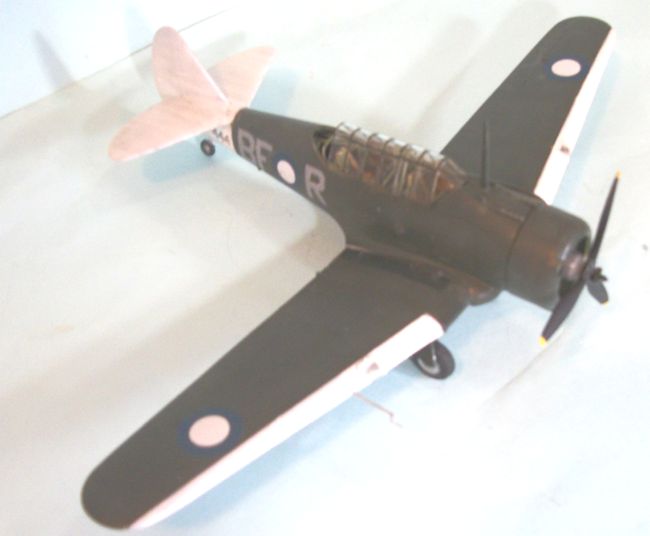 Many RAAF squadrons had at least one Wirraway attached as a squadron
“hack.” One Wirraway, A20‑527, was part of Headquarters Flight 5th Air
Force, flying in full USAAF markings.
Many RAAF squadrons had at least one Wirraway attached as a squadron
“hack.” One Wirraway, A20‑527, was part of Headquarters Flight 5th Air
Force, flying in full USAAF markings.
The Wirraway continued in service after the war as a trainer with
both the RAAF and the Australian Navy.
After CAC Winjeels entered service in 1958, the RAAF phased out its
Wirraways with a farewell flypast held at Point Cook on December 4, 1958, to
mark its retirement. The last RAAF flight was on April 27 1959 when CA‑16
A20‑686 was flown to Tocumwal for disposal.
Ten Wirraways survive on the Australian civil aircraft register, with several others in aviation museums in Australia, Papua New Guinea and the United States.
| THE KIT |
| CONSTRUCTION |
I have been known to say that Special Hobby’s design philosophy is
“Fit? Fit?!
We don’t need no steenking fit!”
There have been kits released in the past that seem as if each
sub-assembly was designed by someone who never interacted with other members
of the design team.
Fortunately, that is n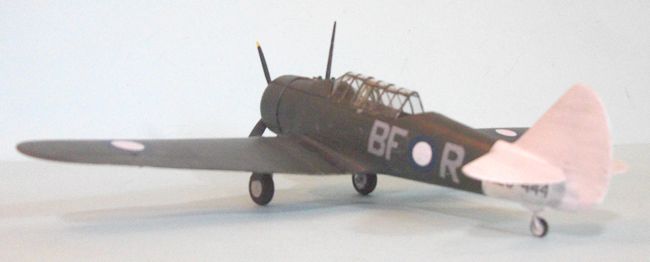 realistic
look.
realistic
look.
I started with the cockpit, which was complicated by the fact that
all the bits and pieces are butt-joined.
I painted it British interior grey-green before proceeding with
assembly. I wished I had an old
Monogram T-6 to steal the cockpit from, but in the end all went together and
fit nicely.
The wings and tail surfaces all have nice sharp trailing edges.
I only needed to use filler along the upper ing to fuselage joint,
and the fuselage centerline.
I did have to reshape the carburetor intake, using photos of
Wirraways to get the shape right.
Other than that, the rest of the model was easy.
| COLORS & MARKINGS |
I decided to do a late-production Wirraway with the overall foliage
green scheme used in New Guinea and Bougainville during 1944-45.
I used Tamiya “Black Green” (RLM 70) which is a close match for
Australian Foliage Green. After
painting the tail and wing leading edges white and masking them off, I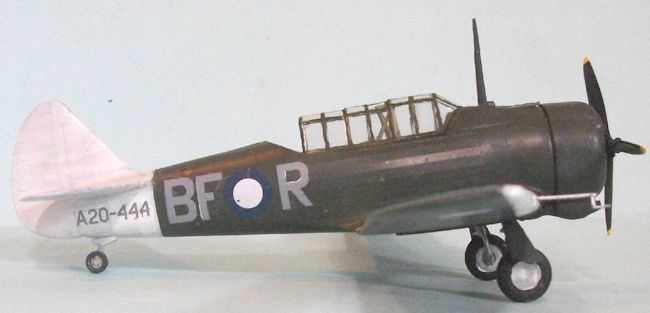 painted the rest in dark green, post shading the paint with applications of
white.
painted the rest in dark green, post shading the paint with applications of
white.
I used a mixture of kit decals and Red Roo decals for the Boomerang,
to create a Wirraway flown by 5 Squadron.
The model was given an overall coat of Xtracrylix clear flat.
| CONCLUSIONS |
January 2014
Review kit courtesy HobbyLink Japan. Get yours at this link.
If you would like your product reviewed fairly and fairly quickly, please contact the editor or see other details in the Note to Contributors.